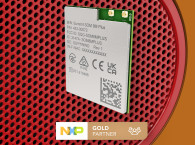
During sports and fitness activities, the wires of today’s earbuds are a genuine inconvenience and can potentially be unsafe. Truly wireless earbuds would provide substantially increased user comfort for sport activities, but in general in all situations where wires are undesired and annoying to users.
Currently, existing earbuds still have a wired connection from ear to ear. This is largely due to the fact that sending a stereo audio stream towards two distinct earbuds is not possible with today’s 2.4GHz technology. A standard Bluetooth A2DP profile, which supports only point-to-point connections, does not support this use case. Forwarding a high quality audio stream from one ear to the other using reasonable power levels is notoriously difficult using 2.4 GHz technology because most of the signal is absorbed by the human body tissue.
The wireless technology being used to enable truly wireless earbuds is based on Near Field Magnetic Induction (NFMI). NFMI features important properties such as ultra-low power consumption and the ability to create a very reliable network in and around the human body, with both high-quality audio and data streaming supported over small distances (< 1m). An additional integration advantage is also that it requires few external components. NFMI is a short range technology and as such also creates a private network, making it is much less susceptible to interference than 2.4 GHz transceivers.
NXH2280 is NXP’s second generation fully integrated single-chip NFMI radio transceiver. Operating from a 1V supply, it only consumes 1.5 mW when audio is streamed in a truly wireless earbud application. The chip supports a maximum bitrate of 596kbps, and can be configured to operate either stand-alone or in conjunction with an MCU. An embedded ultra-low power CoolFlux DSP provides flexibility for the implementation of audio processing algorithms. The flexible network stack supports up to 15 devices, low latency communication (< 5ms) and multiple simultaneous audio and data streams in receive and transmit mode. The component is available in a WLCSP package.
During the MWC 2015 Congress in Barcelona, NXP will be demonstrating the NFMI technology in truly wireless earbuds including wireless audio streaming from ear to ear.
www.nxp.com






